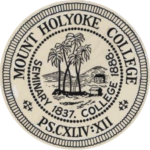Mount Holyoke College
Massachusetts
1837


The blue school color of Mount Holyoke College is a bright and vivid blue, based upon the blue ribbon sashes worn by graduates on their white dresses at this women’s college in the 19th century. That said, a considerable amount of variation between light blue and bright blue can be seen in vintage memorabilia from the college. This is because at the 1893 Chicago Columbian Exposition, light blue was used in an exhibit for the college, which was apparently a misinterpretation of the actual school color based on the faded color of one of the original ribbons. But the “true” college color of Mt. Holyoke is a bright blue, a darker shade than light blue.
Citations in the World Almanac (listed by cover date; color information is from the previous year): light blue (1896-1900); pale blue (1902-1904); light blue (1906-1911); blue (1912-1913); light blue (1914-1918); blue (1923-1931); pale blue (1934-1935)



Mt. Holyoke College was a client of Cotrell & Leonard before the Intercollegiate Code of Academic Costume was created in 1895, according to “The Cap and Gown in America”, an article written in May 1893 for The University Magazine by Gardner Cotrell Leonard, a partner in the Cotrell & Leonard firm and the Director of the Intercollegiate Bureau of Academic Costume (IBAC). Mt. Holyoke also appeared in Cotrell & Leonard advertisements in the 1896 Illio yearbook of the University of Illinois and in the 1899 edition of The Llamarada yearbook of Mt. Holyoke. Further, a reporter covering commencement ceremonies at the University of Chicago for the Indianapolis News (9 July 1896) mentioned Mt. Holyoke as one of a number of colleges and universities that used academic costume. So it seems safe to assume that the Intercollegiate Bureau assigned the college a hood lining design in 1895 or 1896.
None of these references described the hood design assigned to Mt. Holyoke during this period, but in a short IBAC list in the 27 July 1902 Argus newspaper, the college’s hood lining was described as being a single color of light blue. This description did not change in any IBAC list thereafter.
Unfortunately this was an inaccurate interpretation of the actual shade of bright blue adopted by Mount Holyoke in the 19th century. The correct shade has been restored here.